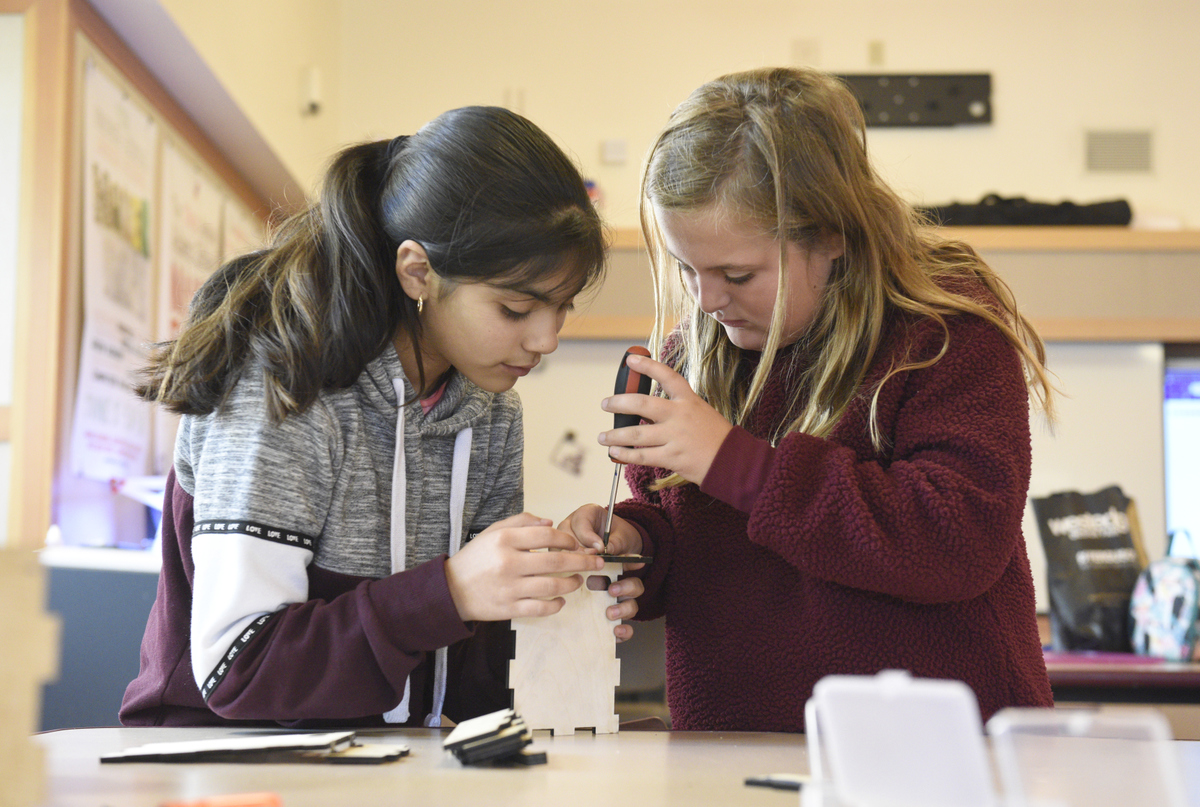Adams’s Design Center Lets Kids Build Stuff
Elementary School Grows Budding Engineers

Ben Caputo and Jacob Kourakis spend nearly every recess period at Adams Elementary away from the playground.
No, the duo from the 5th and 6th grades aren’t in trouble. They are building a model glider in the school’s design center. They’re three months into their project and currently working on the third model — they hope this one will fly.
The boys are building the glider with the Design Center’s 3D printer. They use a website, Computer Aided Design (CAD), for design templates — the same site professional engineers use. This specific project isn’t for a class. They’re just spending more time in the classroom because it’s fun.

“There is a lot of creativity in engineering,” Jacob said. “You have the space to design anything; it’s endless.”
There are five elementary schools in the Santa Barbara district with Science, Technology, Engineering, Art, and Math (STEAM) centers, but Adams’s design center is cutting edge. The space allows the elementary-aged students to learn through hands-on processes and tools like coding, laser cutting, soldering, 3D printing, and other design mediums.
“It has completely changed my relationship with making mistakes,” said Sean Federbusch, the Design Center teacher. The district funded a year of training for Federbusch at Dos Pueblos Engineering Academy so he could take over as teacher of the Adams Design Center.
“Students get to see me make a mistake, and then we figure out how to fix it,” Federbusch said. “Actually, the students often are the ones giving me ideas.”
Federbusch often creates assignments that focus on the environment because he feels that design shouldn’t just be fun — it should serve a purpose, too.
“Good engineers solve problems and give back to the community,” he said. “And environmental literacy is something I believe is important for the kids to understand.”

For instance, the kids in his class now are building light boxes, but they must have an environmental theme. Roberto Rosales Catalan is designing his lightbox to have a skateboard inside because they are an alternative mode of transportation that doesn’t burn fossil fuels.
Although students from the pre-K level through 6th grade visit Federbusch’s class once a week, Roberto went to another elementary school before 3rd grade and hadn’t had any experience like the Design Center until he transferred to Adams.
“I really like being able to do things with my hands,” Roberto said. “I like building and touching the materials. And I really like working in teams.”
Federbusch said the majority of all projects done in his class are in groups or teams; the kids have their own individual projects but they are rarely alone in designing and building them.
Rosie Murray said she loves the group work aspect of the Design Center. The center can be even more important for future female engineers. The disparity between men and women in the engineering workforce is staggeringly high, and research shows that introducing the subject to girls at the elementary age can help close the gap.
“I love it here because my brain just works here,” Rosie said. “We do creative things, and it feels like I’m on a break from school, even though I’m still at school.”
Rosie said she aspires to work in the field when she grows up because of the class.

The Design Center isn’t cheap, though. In the past, some students could access such high-level equipment only if they were lucky enough to be in an after-school program that offered it. For all students, however, the only way to gain access is when it’s built into the school day. It costs about $15,000 a year to cover the costs of all consumables and projects for all students in Adams’s K-6th program.
“Ten years ago, we started going to private schools and asking ourselves what do they have that we can bring to Adams?” said Allison Bell, the president of the Adams Parent Teacher Association (PTA). Bell has three children, two of whom attend Adams in the 5th and 2nd grades.
Bell said the PTA commits $10,000 to $15,000 a year to the materials and operational budget, and each year the Design Center partners with an engineering company with similar environmental values to help cover more costs. But as a Title I school, continuing to find the funds to cover the costs of all consumables and projects is increasingly difficult.
“This the center’s fifth year, and we [the PTA] are so supportive of Sean’s vision,” Bell said. “His ability to engage the kids and the skills they gain is worth finding creative funding sources to keep it going.”
Federbusch set up a wishlist for parents or others who’d like to contribute, located here.




You must be logged in to post a comment.